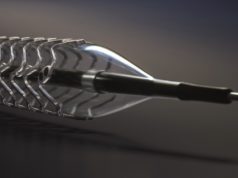
Early data presented at the Transcatheter Cardiovascular Therapeutics annual meeting (TCT 2021; 4–6 November, Orlando, USA and virtual) suggest there may be a future for the use of sirolimus-coated balloons, offering an alternative to paclitaxel for the treatment of both in-stent restenosis and de novo lesions.
Late-breaking studies delivered by Wan Asman Wan Ahmad (University Malaya Medical Center, Kuala Lumpur, Malaysia) and Bruno Scheller (University of Saarland, Saarland, Germany) have provided initial insights into the use of the sirolimus-coated SeQuent (B Braun) balloon compared with a paclitaxel-coated balloon (PCB). A further presentation by Kai Xu (General Hospital of Northern Theater Command, Shenyang, China) delivered during the same session has detailed findings from BIO-RISE CHINA trial, assessing the safety and efficacy of a Biolimus A9 (BA9)-coated balloon compared to plain balloon angioplasty (POBA).
“Paclitaxel-coated balloons are the standard of care for the treatment of coronary in-stent restenosis outside of the USA,” Scheller said in the introduction to his presentation, which summarised the findings of two trials, FIM Malaysian and a German-Swiss randomised study comparing the SeQuent sirolimus-coated balloon (SCB, 4μg/mm²) with the SeQuent Please Neo PCB (3μg/mm²).
The studies had a primary endpoint of angiographic late lumen loss—the angiographic minimum lumen diameter immediately after percutaneous transluminal angioplasty minus the minimum lumen diameter at angiographic follow-up—at six months with a non-inferiority margin of 0.35mm to test the difference in SCB and PCB.
“The use of limus on a balloon is far more complicated than the use on a stent because with a stent platform you can guarantee the controlled release of the drug in the tissue to allow for long therapeutic levels of the drug,” Scheller told TCT attendees. “In the case of the balloon application, you only have this one-time drug transfer, and you have to allow for an amount of the drug to be transferred,” he went on to explain. “In addition, you have to allow for a longer persistence of the drug to guarantee therapeutic effect. This is easier with paclitaxel because you have irreversible binding of the drug to the microtubes in the cell, whereas limus and its analogues have reversible binding.”
Both the Malaysian and German-Swiss studies were conducted in parallel, Scheller explained, using an identical study protocol. In total, 101 patients were randomised, 50 in the SCB group and 51 in the PCB group. Patients underwent clinical follow-up at 30 days, six months and 12 months.
Detailing the clinical characteristics of the two groups, Scheller noted that there was very little difference between the two groups, and that a majority of patients had multivessel disease. Looking at the primary endpoint, Scheller noted that distribution of late lumen loss was similar in the two groups, 0.30mm in the SCB group and 0.30mm in the PCB group for in-lesion late lumen loss, and 0.26mm in the SCB group and 0.25mm in the PCB group for in-segment late lumen loss.
These findings led Scheller to conclude that that a novel sirolimus-coated balloon with a highly crystalline coating with 4µg/mm2 balloon surface was non inferior to a best-in-class PCB with respect to angiographic late lumen loss at six months.
“Since coating of balloons with limus agents is relatively complex, I think the findings are not applicable to other SCBs,” he said. “The question we can discuss is whether there are potentially differential indications potentially for SCBs versus PCBs also with respect to late lumen enlargement for de novo lesions. Of course, we need longer follow with larger trials powered for clinical endpoints to further investigate sirolimus-coated balloons, so for now paclitaxel-coated balloons remain the standard,” Scheller summarised.
Prior to Scheller, Kai Xu presented insights from BIO-RISE CHINA, a multicentre randomised superiority trial in 10 centres in China. The first-in-human study assessed the safety and efficacy of a Biolimus A9 (BA9, Biosensors) DCB in patients with small vessel coronary artery disease undergoing percutaneous coronary intervention (PCI). Patients were eligible if they had small vessel native coronary artery disease, defined as reference vessel diameter 2–2.75mm.
The study had a primary endpoint of in-segment late lumen loss at nine months assessed by an independent core-lab blinded to treatment assignment. Secondary endpoints included device and procedural success, binary restenosis, target lesion failure (TLF) at 30 days and at six, nine and 12 months. Patient orientated clinical outcome (POCO) was defined as a composite of all-cause death, myocardial infarction and any revascularisation at the same timepoints.
Xu told TCT attendees that in total, 212 patients were randomised between treatment with the BA9-coated balloon and POBA. The study met its primary endpoint by demonstrating a statistically significant reduction of late lumen loss with the BA9-coated balloon compared to POBA at nine months (0.16±0.29mm vs. 0.30±0.35mm ∆ 0.14mm; 95% CI -0.23 to -0.05; p=0.001).
“This first-in-human randomised controlled trial has confirmed the safety and efficacy of a biolimus-coated balloon in patients with small vessel coronary artery disease compared to plain old balloon angioplasty,” Xu remarked in his closing statements. He noted that late lumen enlargement was three times more common with the biolimus-coated balloon, with a trend towards improved clinical outcomes at one year. “Future studies are warranted to compare the biolimus-coated balloon to DES and/or other DCBs,” he remarked.

The presentations prompted a discussion between TCT panellists about the future for the use of DCBs in the coronary arteries. Session chair Juan Granada (president and chief executive officer of the Cardiovascular Research Foundation [CRF], organiser of the TCT event) said that the studies marked the first time there had been data available for three sirolimus-coated balloons “showing some consistency and findings”.
However, he asked Scheller to comment on whether the shorter delivery time for sirolimus than for paclitaxel is likely to be problematic. “Sirolimus is more difficult to handle than paclitaxel, and one of the things that I am concerned about is the durability of the event. With paclitaxel you can really find it in the artery for a long time, but sirolimus goes away quickly once it is dissolved. Is it a potential late catch up, something that stays in your head as a concern?” Granada said to Scheller.
Scheller responded: “That is one of the unanswered questions and that is my concern too. Therefore, I think we have to declare that the results we have seen today are very promising, but we only have this short follow-up time, and we cannot give any answer on a potential late catch-up, for example, with sirolimus and its reversible binding.”
Another of the panellists, Wayne Batchelor (Inova Heart and Vascular Institute, Falls Church, USA), questioned the use of late lumen loss as a primary endpoint in the trials, commenting that, for patients, “it is target vessel revascularisation and in-stent restenosis that lead to symptoms and that is where there might be a little bit of a disconnect”.
To this point, Scheller responded: “I fully agree with what you are saying. The point is that, at the moment, we are in the very early stage of learning about sirolimus-coated balloons, and at this early stage it is important mechanistically. Do we have the biological effect that we expect from the preclinical trials? Can we translate and find this effect in humans? This is what was addressed by these three trials. This is not an answer about what the clinical impact will be.”












